Simulated Validation and Prediction of Land Use under Multiple Scenarios in Daxing District, Beijing, China, Based on GeoSOS-FLUS Model
Abstract
:1. Introduction
2. Materials
2.1. Study Area
2.2. Data Sources and Processing
3. Methods
3.1. Site Size Forecasting Based on Markov Chain Model
3.2. Simulation of Land-Use Morphology Based on GeoSOS-FLUS Model
3.2.1. Selection of Driving Factors
3.2.2. Parameter Measurements
- (1)
- Total demand
- (2)
- Land-use Simulation Under Multiple Scenarios
- (3)
- Set parameters for each land-use type domain factor
- (4)
- Cellular Neighbourhood Size and Accuracy Test
4. Results
4.1. Analysis of Land-Use Change Area from 2008 to 2018
4.2. Land-Use Change Prediction from 2018 to 2038
4.3. Natural Development Scenario Simulation Results
4.4. Cultivated Land Protection Scenario Simulation Results
4.5. Cultivated Ecological Control Scenario Results
5. Discussion
6. Conclusions
Author Contributions
Funding
Institutional Review Board Statement
Informed Consent Statement
Data Availability Statement
Acknowledgments
Conflicts of Interest
References
- Wang, S.Y. Research on the Landscape Ecological Planning and Design of the Urban Fringe Green Space D; Beijing Forestry University: Beijing, China, 2012. [Google Scholar]
- Liu, H.B.; Zhai, G.F.; Shi, Y.J. Analysis of land-use problems in urban fringe from the perspective of spatial reconstruction. In Rational Planning for Sustainable Development—2017 China Urban Planning Annual Conference Proceedings (16 Regional Planning and Urban Economy); Urban Planning Society of China: Guangdong, China, 2017; pp. 1162–1170. [Google Scholar]
- Guo, R.Q.; Lu, B.; Chen, K.L. Dynamic simulation of multi-scenario land-use change based on CLUMondo model: A case study of coastal cities in Guangxi. Remote Sens. Land Resour. 2020, 1, 176–183. [Google Scholar] [CrossRef]
- The Central Committee of the Communist Party of China State Council. The Central Committee of the Communist Party of China State Council issues the Strategic Plan for Rural Revitalization (2018–2022); The Central Committee of the Communist Party of China State Council: Beijing, China, 2018; Volume 29, pp. 9–47.
- Louis, H.; Fischer, K. Allgemeine Geomorphologie: Textteil u. gesonderter Bilderteil; Walter de Gruyter: Berlin, Germany, 1979. [Google Scholar]
- Muller, P.O. The Suburban Transformation of the Globalizing American City. Ann. Am. Acad. Polit. Soc. Sci. 1997, 551, 44–58. [Google Scholar] [CrossRef]
- Browder, J.O.; Bohland, J.R.; Scarpaci, J.L. Patterns of Development on the MetropolitanFringe: Urban Fringe Expansion in Bangkok, Jakarta, and Santiago. J. Am. Plan. Assoc. 1995, 61, 310–327. [Google Scholar] [CrossRef]
- Whitehand, J.W.R.; Morton, N.J. Urban Morphology and Planning: The Case of Fringe Belts. Cities 2004, 21, 275–289. [Google Scholar] [CrossRef]
- Phelps, N.A. Edge Cities. In Amsterdam: International Encyclopedia of Human Geography; Elsevier: Amsterdam, The Netherlands, 2009. [Google Scholar]
- Lin, Y.C.; Deng, X.Z.; Zhan, J.Y. Simulation of Regional Land Use Competition for Jiangxi Province. Resour. Sci. 2013, 35, 729–738. [Google Scholar]
- Wang, X.Y.; Zhou, Y.; Yu, J.N. Evolution of Green Infrastructure Layout and Waterlogging Risk Assessment Based on Cellular Automata Simulation of Urban Expansion: A Case Study of Wuhan City. Landsc. Archit. 2020, 27, 50–56. [Google Scholar] [CrossRef]
- Mondal, M.S.; Sharma, N.; Kappas, M.; Garg, P.K. Cellular automata (CA) contiguity filters impacts on ca Markov modeling of land use land cover change predictions results. Int. Arch. Photogramm. Remote Sens. Spat. Inf. Sci. 2020, 43, 1585–1591. [Google Scholar] [CrossRef]
- YI, D.; Zhao, X.M.; Guo, X.; Zhao, L.H.; Zhang, H.; Han, Y.; Subedi, R.; Luo, Z.J. Delimitation of urban development boundary based on ecological sensitivity evaluation and CA-Markov simulation in the plain city: A case of Nanchang, Jiangxi, China. Chin. J. Appl. Ecol. 2020, 31, 208–218. [Google Scholar] [CrossRef]
- Zhang, X.J.; Zhou, Q.G.; Wang, Z.L.; Wang, F.H. Simulation and prediction of land use evolution in the Three Gorges reservoir area based on MCE-CA-Markov. J. Agric. Eng. 2017, 33, 268–277. [Google Scholar]
- Long, Y. Study on the Dynamic Evolution and Feature of Landscape Pattern in Wuhan Urban Fringe. In Proceedings of the 2018 Annual Conference of the Chinese Society of Landscape Architecture, Guizhou, China, 20 October 2018; pp. 311–314. [Google Scholar]
- Aslan, N.; Koc-San, D. Spatiotemporal Land Use Change Analysis and Future Urban Growth Simulation Using Remote Sensing: A Case Study of Antalya. Int. Arch. Photogramm. Remote Sens. Spat. Inf. Sci. 2020, 43, 657–662. [Google Scholar] [CrossRef]
- Liu, X.; Zhao, Y.X.; Feng, X.M.; Wu, A.B.; Li, R.H. Simulation and optimization of multi-objective land use pattern based on CLUE-S model: An example from Beisan County, Langfang City, Hebei Province. Geogr. Geogr. Inf. Sci. 2018, 34, 92–98. [Google Scholar]
- Kucsicsa, G.; Popovici, E.-A.; Bălteanu, D.; Grigorescu, I.; Dumitraşcu, M.; Mitrică, B. Future Land Use/Cover Changes in Romania: Regional Simulations Based on CLUE-S Model and CORINE Land Cover Database. Landsc. Ecol. Eng. 2019, 15, 75–90. [Google Scholar] [CrossRef]
- Li, K.Y.; Zhang, Y.F.; Yang, Q.S. Simulation of spatial expansion of Xi’an city based on CA model and error analysis. Mapp. Sci. 2011, 36, 106–108+111. [Google Scholar] [CrossRef]
- Wu, J.S.; Feng, Z.; Huang, L.; Gao, Y.; Peng, J.; Huang, X.L. Sustainable land use scenario prediction based on CLUE-S model framework: An example from Yangquan suburban area. Resour. Sci. 2011, 33, 1699–1707. [Google Scholar]
- Liu, X.; Liang, X.; Li, X.; Xu, X.; Ou, J.; Chen, Y.; Li, S.; Wang, S.; Pei, F. A Future Land Use Simulation Model (FLUS) for Simulating Multiple Land Use Scenarios by Coupling Human and Natural Effects. Landsc. Urban Plan. 2017, 168, 94–116. [Google Scholar] [CrossRef]
- Li, Y.L. Research on Land Use Change and Simulation in Yubei District of Chongqing in the Context of Coordinated Development between Ecology and Economy. Master’s Thesis, Southwest University, Nanjing, China, 2019. [Google Scholar]
- Huo, J.; Shi, Z.; Zhu, W.; Xue, H.; Chen, X. A Multi-Scenario Simulation and Optimization of Land Use with a Markov–FLUS Coupling Model: A Case Study in Xiong’an New Area, China. Sustainability 2022, 14, 2425. [Google Scholar] [CrossRef]
- Zhang, Y.; Li, C.; Zhang, L.; Liu, J.; Li, R. Spatial Simulation of Land-Use Development of Feixi County, China, Based on Optimized Productive–Living–Ecological Functions. Sustainability 2022, 14, 6195. [Google Scholar] [CrossRef]
- Geomorphological Profile of Daxing District_Daxing Public Interest Geological Information_Beijing Municipal Commission of Planning and Natural Resources. Available online: http://ghzrzyw.beijing.gov.cn/ziranziyuanguanli/gyxdzzl/dx_gyxdzzl/202005/t20200511_1894545.html (accessed on 12 June 2022).
- Wu, Z.Z.; Song, J.P.; Wang, X.X.; Cheng, Y.; Zhang, N. On urbanization process and spatial expansion in the urban fringe of Beijing: A case study of Daxing District. Geogr. Res. 2008, 2, 285–293+483. [Google Scholar]
- Fang, L.N.; Chen, Y.J.; Song, J.P. The Evaluation of Land Use Benefit in Urban Fringe Area: An Example of Daxing District, Beijing. Chin. Agric. Sci. Bull. 2013, 29, 154–159. [Google Scholar]
- Daxing District Land Use Master Plan (2006–2020)_Daxing Master Plan_Beijing Municipal Commission of Planning and Natural Resources. Available online: http://ghzrzyw.beijing.gov.cn/zhengwuxinxi/ghcg/ztgh/dx_ztgh/201912/t20191213_1730430.html (accessed on 12 June 2022).
- Guo, H.; Cai, Y.; Yang, Z.; Zhu, Z.; Ouyang, Y. Dynamic Simulation of Coastal Wetlands for Guangdong-Hong Kong-Macao Greater Bay Area Based on Multi-Temporal Landsat Images and FLUS Model. Ecol. Indic. 2021, 125, 107559. [Google Scholar] [CrossRef]
- Wang, X.D.; Yao, Y.; Ren, S.L.; Shi, X.G. A coupled FLUS and Markov approach to simulating spatial patterns of land use in fast-growing cities. J. Geoinform. 2022, 24, 100–113. [Google Scholar]
- Jin, M.T.; Xu, L.P.; Xu, Q. Multi-scenario landscape ecological risk evaluation and prediction based on the FLUS-Markov model: An example from Kechu, South Xinjiang. Arid Zone Res. 2021, 38, 1793–1804. [Google Scholar] [CrossRef]
- Daxing Zoning Plan (Territorial Spatial Planning) (2017–2035) _Zoning Plan_Beijing Municipal Commission of Planning and Natural Resources. Available online: http://ghzrzyw.beijing.gov.cn/zhengwuxinxi/ghcg/fqgh/202002/t20200213_1630085.html (accessed on 21 August 2022).
- Hao, X.J. Land Use Pattern Characteristics, Dynamic Changes and Simulation in the Coal Mining Area of Northern Shanxi Province. Master’s Thesis, Shanxi University, Shanxi, China, 2020. [Google Scholar] [CrossRef]
- Hao, R. Analysis on Driving Forces of Land-Use Change and Simulation of Scenarios of Qinhuangdao. Master’s Thesis, Hebei Normal University, Hebei, China, 2017. [Google Scholar]
- Chuai, X.W. Carbon Effect Caused by Landuse Changes and Its Land Use Control in Coastal Regions—The Case Study of Coastal Region in Jiangsu Province D; Nanjing University: Nanjing, China, 2013. [Google Scholar]
- Wang, J.; Zhang, J.; Xiong, N.; Liang, B.; Wang, Z.; Cressey, E.L. Spatial and Temporal Variation, Simulation and Prediction of Land Use in Ecological Conservation Area of Western Beijing. Remote Sens. 2022, 14, 1452. [Google Scholar] [CrossRef]
- Lin, P.F.; Zheng, R.B.; Hong, X.; Zheng, X.; Zheng, W.L. Simulation of land use spatial layout based on FLUS model—A case study of Huadu District, Guangzhou. Territ. Nat. Resour. Study. 2019, 2, 3. [Google Scholar] [CrossRef]
- Xu, Y.Q.; Luo, D.; Guo, H.F.; Zhou, D. Multi-simulation of Spatial Distribution of Land Use Based on CLUE-S Model: A Case Study of Yuzhong County, Gansu Province. Acta Sci. Nat. Univ. Pekin. 2013, 49, 523–529. [Google Scholar] [CrossRef]

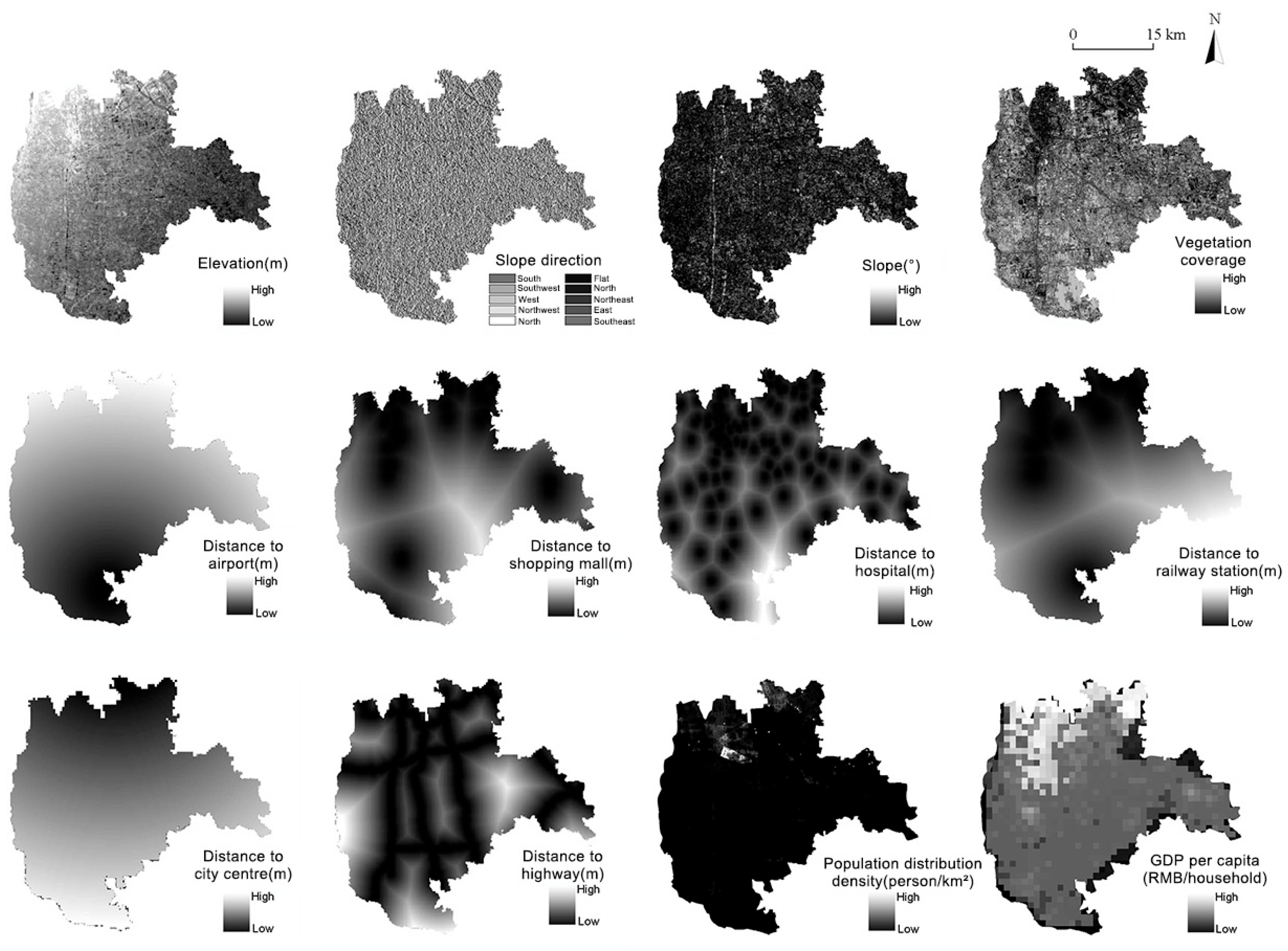
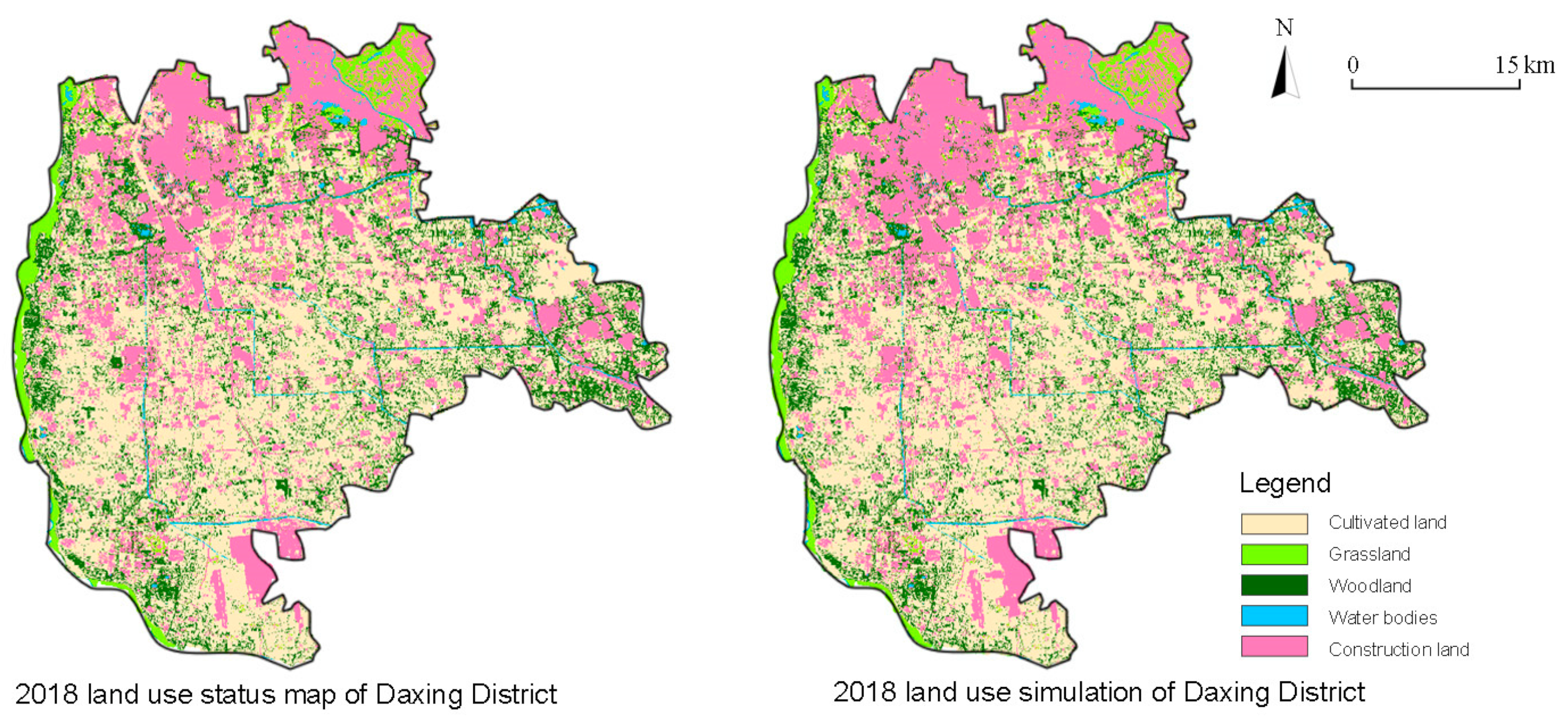
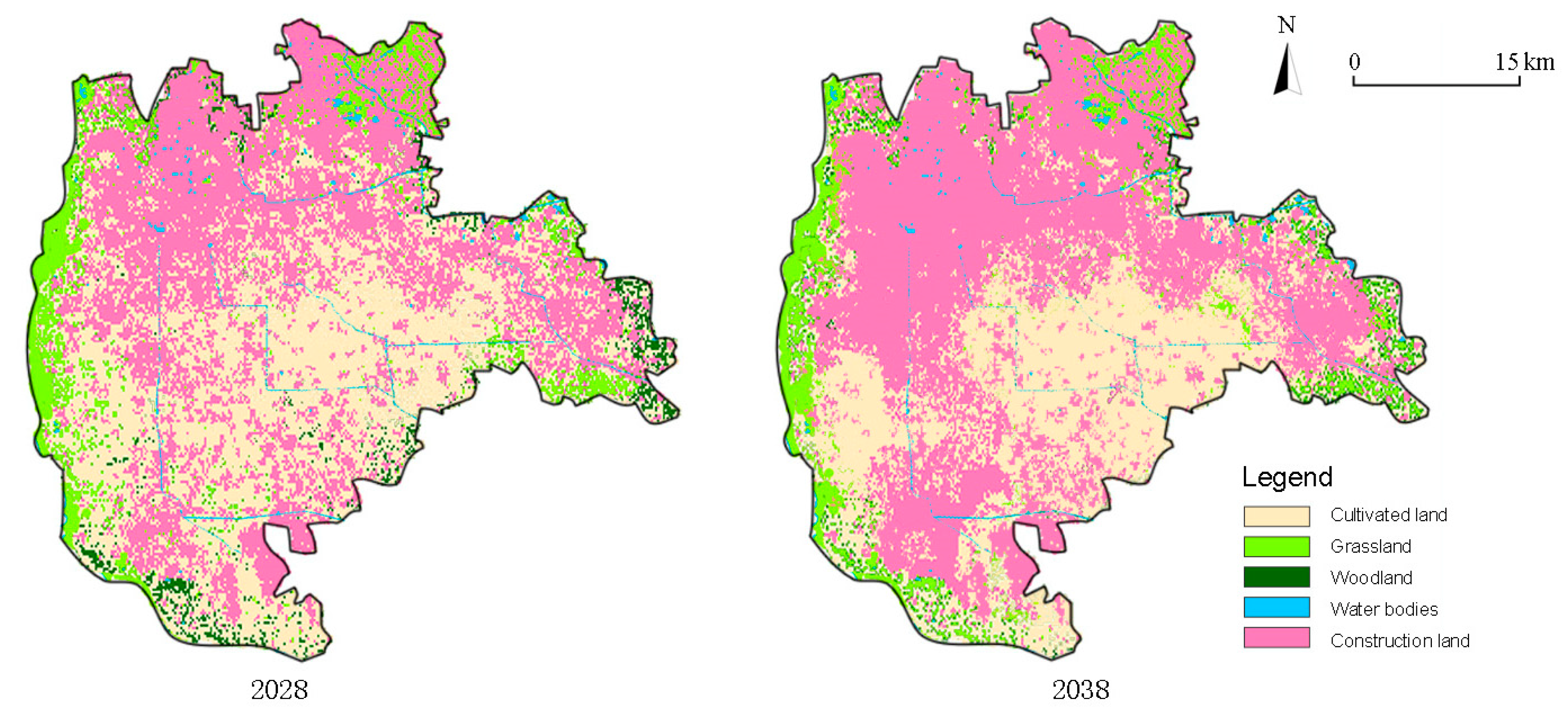

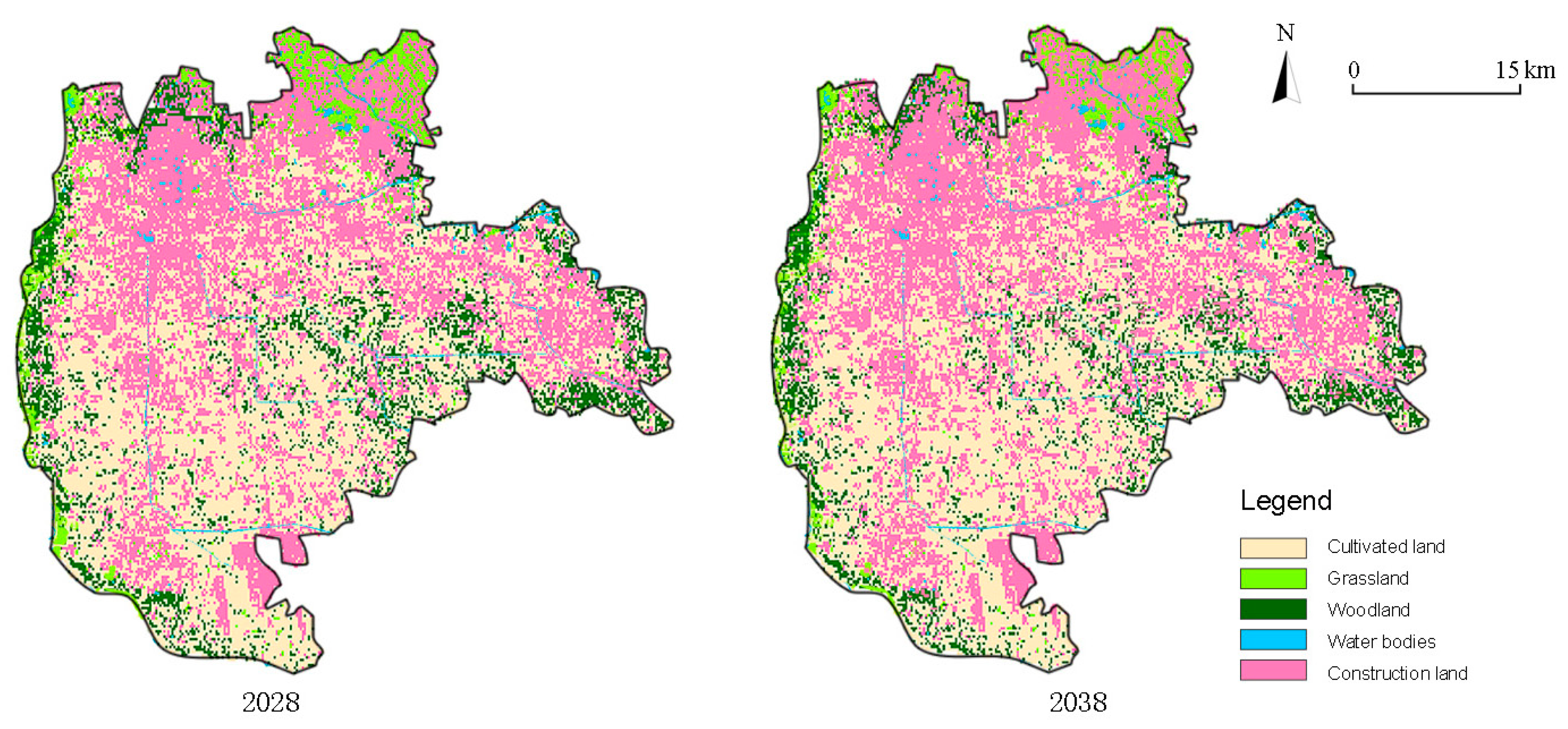
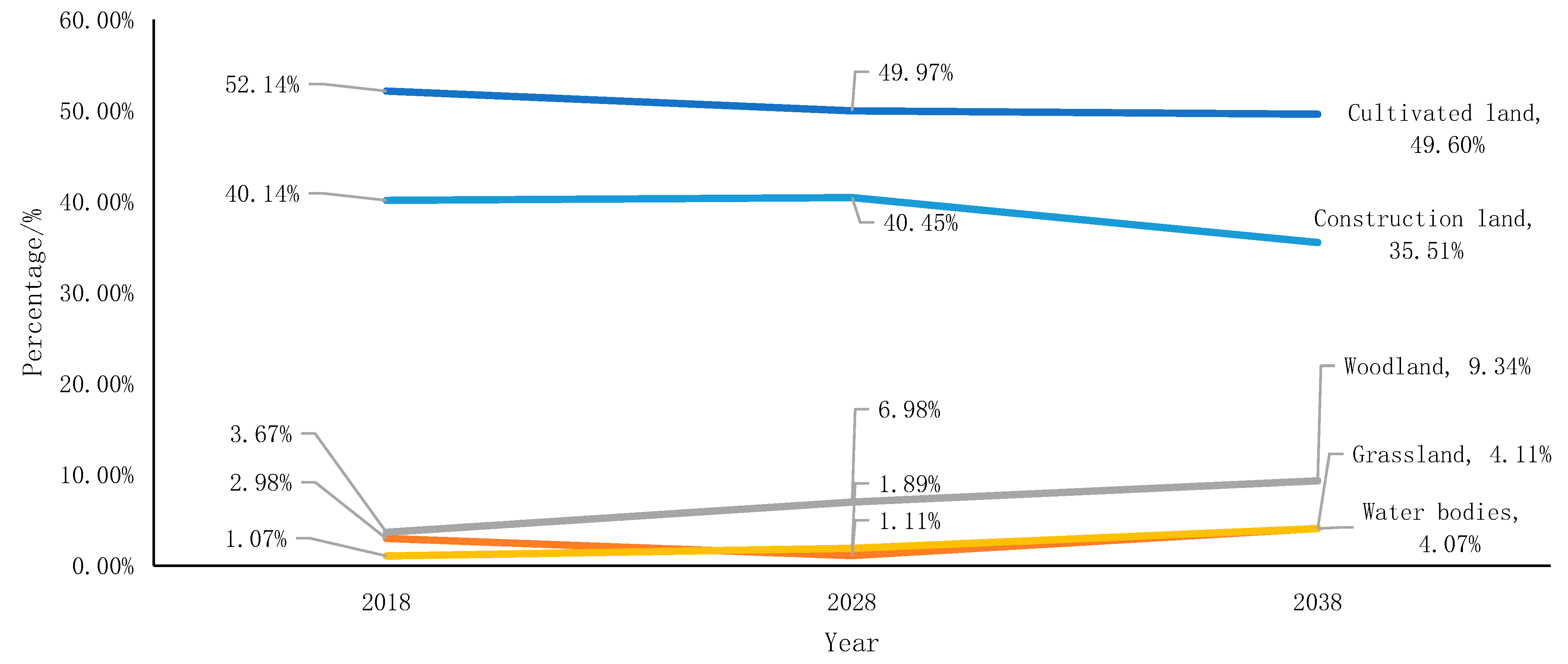
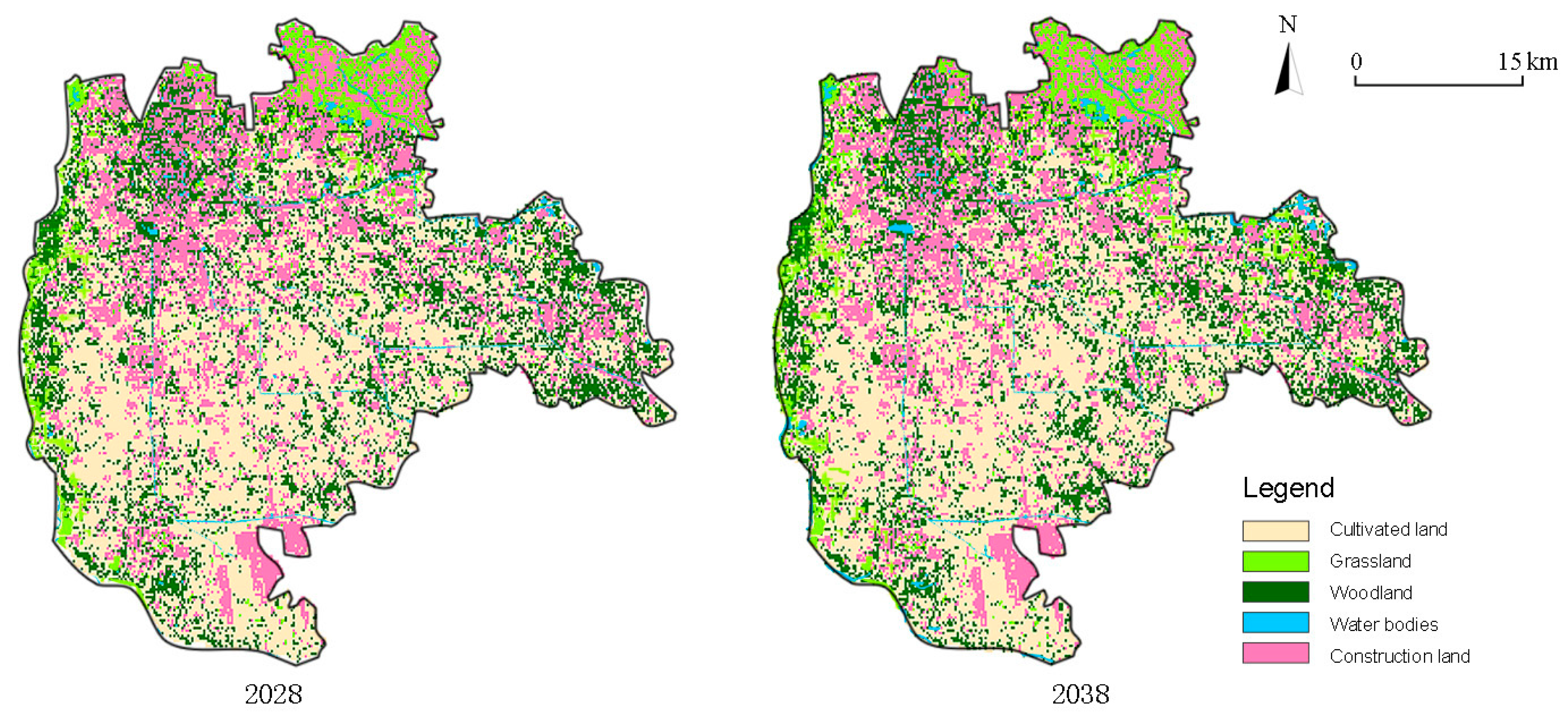
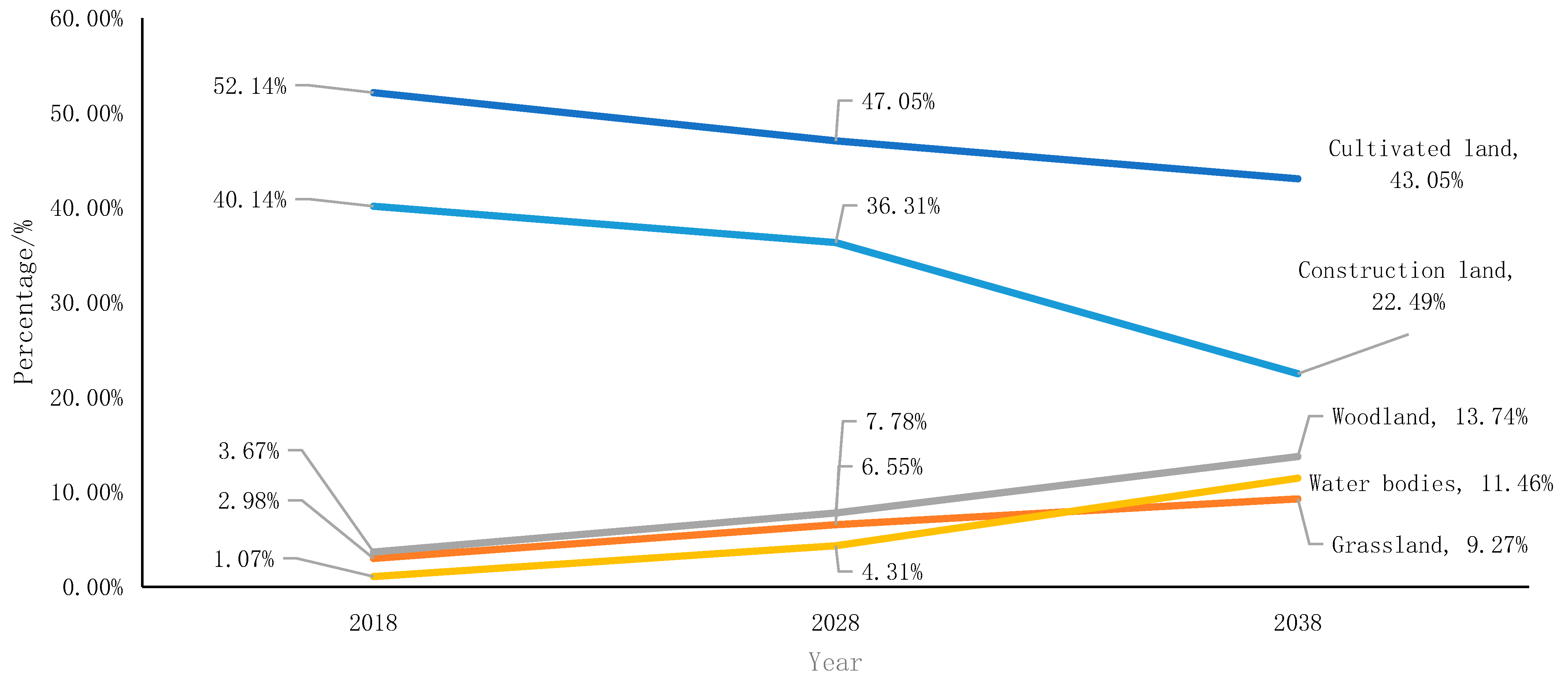
| Category | Data Name | Data Format | Data Source | Year |
|---|---|---|---|---|
| Land database | Land-use data | 30 m × 30 m raster | Institute of Geographical Sciences and Resources, Chinese Academy of Sciences (Source: http://www.resdc.cn (accessed on 21 March 2022)) | 2008 and 2018 |
| Natural environmental factors | Elevations | Digital elevation model data (DEM) | Geospatial Data Cloud (http://www.gscloud.cn/search) | 2008 |
| Slope | Calculated from DEM data | - | ||
| Slope direction | Calculated from DEM data | |||
| Vegetation coverage | Normalised difference vegetation index data (NDVI) | Geospatial Data Cloud (http://www.gscloud.cn/search) | ||
| Social factors | Distance to city centre | 30 m × 30 m raster data | - | |
| Distance to airport | ||||
| Distance to railway station | ||||
| Distance to highway | ||||
| Distance to shopping mall | ||||
| Distance to hospital | ||||
| Population distribution | 1 km × 1 km population distribution | Geospatial Data Cloud (http://www.gscloud.cn/search) | ||
| Economic factors | GDP per capita | 1 km × 1 km per capita GDP |
| - | Cultivated Land | Grassland | Woodland | Water Bodies | Construction Land |
|---|---|---|---|---|---|
| 2008 Actual | 29,282 | 4 | 1648 | 1148 | 12,975 |
| 2018 Actual | 23,549 | 1646 | 1344 | 450 | 18,048 |
| 2018 Forecast | 23,544 | 1643 | 1344 | 449 | 18,044 |
| - | - | Cultivated Land | Grassland | Woodland | Water Bodies | Construction Land |
|---|---|---|---|---|---|---|
| Natural development scenarios | Cultivated land | 1 | 1 | 1 | 0 | 1 |
| Grassland | 1 | 1 | 1 | 0 | 1 | |
| Woodland | 1 | 1 | 1 | 0 | 1 | |
| Water bodies | 1 | 1 | 1 | 1 | 0 | |
| Construction land | 0 | 0 | 0 | 0 | 1 | |
| Cultivated land conservation scenarios | Cultivated land | 1 | 0 | 0 | 0 | 0 |
| Grassland | 1 | 1 | 1 | 0 | 1 | |
| Woodland | 1 | 1 | 1 | 0 | 1 | |
| Water bodies | 1 | 1 | 1 | 1 | 0 | |
| Construction land | 0 | 0 | 0 | 0 | 1 | |
| Ecological control scenarios | Cultivated land | 1 | 1 | 1 | 0 | 0 |
| Grassland | 1 | 1 | 1 | 0 | 0 | |
| Woodland | 1 | 1 | 1 | 0 | 0 | |
| Water bodies | 1 | 1 | 0 | 1 | 0 | |
| Construction land | 0 | 0 | 0 | 0 | 1 |
| Type of Land Use | Cultivated Land | Grassland | Woodland | Water Bodies | Construction Land |
|---|---|---|---|---|---|
| Domain Factor | 0.4 | 0.6 | 0.6 | 0.2 | 0.8 |
| Type of Land Use | Cultivated Land | Grassland | Woodland | Water Bodies | Construction Land |
|---|---|---|---|---|---|
| 2008 | 673.49 | 0.10 | 37.91 | 26.41 | 298.42 |
| 2018 | 541.63 | 37.86 | 30.92 | 10.34 | 415.10 |
| Total change 2008–2018 | −131.86 | 37.76 | −6.99 | −16.07 | 116.68 |
| Average annual change 2008–2018 | −13.2 | 3.78 | −0.70 | −1.61 | 11.67 |
| - | - | Cultivated Land | Grassland | Woodland | Water Bodies | Construction Land |
|---|---|---|---|---|---|---|
| Cultivated land | Area/km2 | 489.44 | 5.39 | 15.84 | 6.33 | 156.01 |
| Proportion | 72.67% | 0.80% | 2.35% | 0.94% | 23.16% | |
| Grassland | Area/km2 | 0.00 | 0.02 | 0.00 | 0.00 | 0.08 |
| Proportion | 0.00% | 18.66% | 0.00% | 0.00% | 81.34% | |
| Woodland | Area/km2 | 22.38 | 0.58 | 8.02 | 0.24 | 6.55 |
| Proportion | 59.04% | 1.53% | 21.15% | 0.64% | 17.27% | |
| Water bodies | Area/km2 | 2.38 | 14.00 | 3.93 | 1.70 | 4.30 |
| Proportion | 9.02% | 53.01% | 14.88% | 6.42% | 16.29% | |
| Construction land | Area/km2 | 27.32 | 17.81 | 3.12 | 2.05 | 248.07 |
| Proportion | 9.15% | 5.97% | 1.04% | 0.69% | 83.13% |
| 2018 | Cultivated Land | Grassland | Woodland | Water Bodies | Construction Land |
|---|---|---|---|---|---|
| Predicted value | 541.52 | 37.79 | 30.91 | 10.32 | 415.01 |
| Actual value | 541.63 | 37.86 | 30.92 | 10.34 | 415.10 |
| Difference | −0.11 | −0.07 | −0.01 | −0.02 | −0.09 |
| Type of Land | 2018 | 2028 | 2038 | 2018–2028 | 2028–2038 |
|---|---|---|---|---|---|
| Cultivated land | 541.63 | 450.80 | 389.78 | −90.83 | −61.02 |
| Grassland | 37.86 | 42.12 | 46.86 | 4.27 | 4.73 |
| Woodland | 30.92 | 25.16 | 22.55 | −5.77 | −2.61 |
| Water bodies | 10.34 | 8.80 | 8.45 | −1.53 | −0.35 |
| Construction land | 415.10 | 508.34 | 567.04 | 93.24 | 58.70 |
Publisher’s Note: MDPI stays neutral with regard to jurisdictional claims in published maps and institutional affiliations. |
© 2022 by the authors. Licensee MDPI, Basel, Switzerland. This article is an open access article distributed under the terms and conditions of the Creative Commons Attribution (CC BY) license (https://creativecommons.org/licenses/by/4.0/).
Share and Cite
Chen, X.; He, X.; Wang, S. Simulated Validation and Prediction of Land Use under Multiple Scenarios in Daxing District, Beijing, China, Based on GeoSOS-FLUS Model. Sustainability 2022, 14, 11428. https://doi.org/10.3390/su141811428
Chen X, He X, Wang S. Simulated Validation and Prediction of Land Use under Multiple Scenarios in Daxing District, Beijing, China, Based on GeoSOS-FLUS Model. Sustainability. 2022; 14(18):11428. https://doi.org/10.3390/su141811428
Chicago/Turabian StyleChen, Xin, Xinyi He, and Siyuan Wang. 2022. "Simulated Validation and Prediction of Land Use under Multiple Scenarios in Daxing District, Beijing, China, Based on GeoSOS-FLUS Model" Sustainability 14, no. 18: 11428. https://doi.org/10.3390/su141811428
APA StyleChen, X., He, X., & Wang, S. (2022). Simulated Validation and Prediction of Land Use under Multiple Scenarios in Daxing District, Beijing, China, Based on GeoSOS-FLUS Model. Sustainability, 14(18), 11428. https://doi.org/10.3390/su141811428







